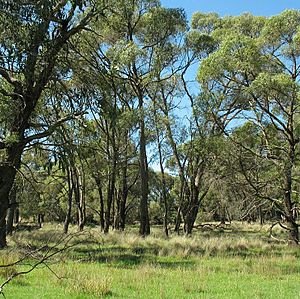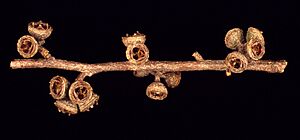Black gum facts for kids
Quick facts for kids Black gum |
|
|---|---|
 |
|
| Eucalyptus aggregata at Grabben Gullen | |
| Conservation status | |
| Scientific classification | |
| Genus: |
Eucalyptus
|
| Species: |
aggregata
|
| Synonyms | |
|
Eucalyptus rydalensis R.T.Baker & H.G.Sm. |
|
The black gum (scientific name: Eucalyptus aggregata) is a special type of tree found only in southeastern Australia. It's a medium-sized tree with rough, flaky bark, and sometimes smooth bark on its upper branches. It has unique lance-shaped leaves, green to yellow flower buds that grow in groups of seven, and pretty white flowers. Its fruit looks a bit like a cup.
Black gum trees often grow in grassy woodlands, especially in low-lying or swampy areas. Sadly, many of these areas have been cleared over time, which means the black gum is now a threatened species.
Contents
What the Black Gum Looks Like
The black gum tree can grow up to about 18 meters (60 feet) tall. Its trunk has dark grey to black bark that feels rough and flaky. But on the branches higher up, the bark is smooth and can be whitish, cream-colored, or grey.
Young black gum plants have leaves that are oval or egg-shaped. These leaves are about 4 to 7 centimeters (1.5 to 3 inches) long and 1.5 to 3 centimeters (0.6 to 1.2 inches) wide. They are a bit lighter green on their underside.
As the tree gets older, its leaves become lance-shaped. They grow in an alternating pattern along the stems. These adult leaves are usually 5 to 12 centimeters (2 to 5 inches) long and 1 to 2 centimeters (0.4 to 0.8 inches) wide. Both sides of the leaf are the same color.
The tree's flower buds grow in groups of seven. Each group is on a small stalk called a peduncle, which is only 1 to 5 millimeters (0.04 to 0.2 inches) long. The individual buds are oval, green to yellow, and about 3 to 5 millimeters (0.1 to 0.2 inches) long. They have a cone-shaped or beaked cap.
The flowers are white and usually bloom from November to May. After the flowers, the tree produces fruit that is shaped like a cup or a cone. These fruits are small, about 2 to 3 millimeters (0.08 to 0.12 inches) long and 3 to 5 millimeters (0.12 to 0.2 inches) wide.
How it Got its Name
The black gum tree was first officially described in 1900 by two scientists, Henry Deane and Joseph Maiden. They found the first samples of this tree in a place called Wallerawang.
The scientific name aggregata comes from a Latin word. It means "clustered," which refers to how the tree's fruit grows in clusters.
Where the Black Gum Lives
Black gum trees are quite rare. They are found in a few scattered places in central and southern New South Wales, and there's also a small group near Woodend in Victoria. Their distribution is "patchy" because a lot of the land where they used to grow has been cleared for farms.
These trees prefer to grow in woodlands. They often share their habitat with other eucalyptus trees like candlebark, ribbon gum, black sally, broad-leaved peppermint, and snow gum. The ground beneath them is usually covered with grasses like river tussock and silver top wallaby grass.
Black gums like to grow in low-lying areas where the soil is often poorly drained, wet, or swampy. These spots are also natural "frost hollows," meaning cold air stays there during the colder months. You'll find black gums at altitudes above 700 meters (2,300 feet), where winters bring heavy frosts and sometimes snow.
Protecting the Black Gum
The black gum is considered a "vulnerable" species. This means it's at risk of becoming endangered if we don't protect it. Both the Australian Government and the New South Wales Government have laws to help protect it.
Scientists estimate there are only about 6,300 to 8,100 mature black gum trees left. Many of these trees are isolated, meaning they are far from other black gums. This makes it hard for their seedlings to grow because they can't compete with weeds around them.
Other threats to the black gum include:
- Hybridisation: They can mix with other eucalyptus species like E. viminalis and E. rubida, which can change their unique characteristics.
- Climate change: As the climate gets warmer, the special "frost hollow" areas where black gums thrive might shrink, making it harder for them to survive.
Uses of the Black Gum
Even though the black gum's wood isn't very strong or useful for timber, the tree is still valuable. It can grow in places where many other local trees struggle. Its dense leaves provide good shade, making it a useful tree for shelter. Also, its leaves can be used as food for animals.



